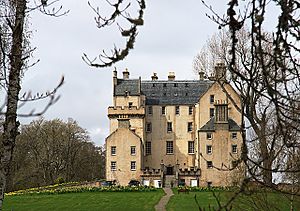James Grant of Freuchie facts for kids
James Grant of Freuchie (born 1616, died 1663) was an important Scottish landowner. He was the seventh Laird, or lord, of Freuchie. His family home, Freuchie Castle, is now known as Castle Grant.

Contents
Life and Work
James Grant was the son of John Grant of Freuchie. He was born on June 24, 1616. When his father passed away in 1637, James became the new Laird of Freuchie.
Supporting the Covenanters
James Grant supported the Covenanters, a group in Scotland who wanted to protect their religious beliefs. In 1639, he bought blue ribbons for himself and his followers in Aberdeen. This was a way to show everyone his strong support for the Covenanters.
Improvements at Castle Grant
James Grant continued to improve his family home, Castle Grant. His father had hired John Anderson to paint the gallery with "fine colours" in 1635. James Grant hired two masons, Robert Torrie and James Mason, in 1649. They worked to rebuild and make two chimneys taller. They also fixed the leaking battlements on the old towers.
Grant also employed a fowler named John Innes. A fowler's job was to hunt birds like waterfowl and partridges. These birds were then served for meals at the castle. Music at Castle Grant was provided by Alexander Cumming, who played the bagpipes and the viola.
Helping the King
After King Charles II returned to power in Scotland, James Grant had a duty to help. He had to send workers from his lands to help tear down the fortified citadel in Inverness. This work party was led by John Grant of Craggan.
Family Life and Beliefs
In 1658 and 1661, James Grant and his family traveled to Edinburgh. They had their portraits painted by an artist named David Scougall. His wife, Mary Stewart, Lady Grant, used a special "chariot" for travel. This suggests she might have had a disability.
Concerns About Witchcraft
During their visit to Edinburgh in 1661, the family also dealt with legal matters. Lady Grant was worried about witchcraft. She believed that witches might try to harm her children. At that time, many people in Scotland believed in witchcraft. James Grant sought advice from Sir Peter Wedderburn, a legal expert. He went to the Privy Council to get permission for a special hearing. This hearing was to look into concerns about witchcraft in his area.
On October 3, 1661, a special permission was given. It allowed for a hearing about two women, Issobell Munro and Mary Burges. They were described as "vagabonds" and were suspected of witchcraft in Strathspey and Murrayland.
Portraits and Amulets
James Grant passed away in 1663 in Edinburgh. He was buried at Holyrood Abbey. The portraits of James Grant and Lady Grant, painted in 1658, are now kept at the National Museums of Scotland. In her portrait, Lady Grant holds an apple pomander. She also wears bracelets made of beads, possibly coral or amber. These beads were often thought to be a kind of amulet. People believed they could offer magical protection against accidents or illness.
Marriage and Children
Around April 24, 1640, James Grant married Margaret or Mary Stuart. She was the daughter of James Stuart, 3rd Earl of Moray. There was some disagreement about their marriage. They were married in Elgin, where Mary was staying. The minister who performed the wedding, Gilbert Marshall, was suspended for three weeks. This happened because he did not announce the wedding beforehand as was customary.
James and Mary had several children:

